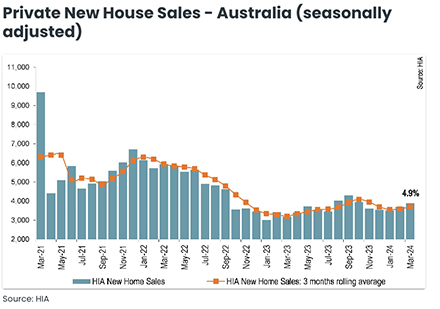The prospect of a pick-up in home building activity in 2024 is not likely given the low volume of new homes sales in the first three months of 2024, according to the HIA. Source: Timberbiz
The HIA New Home Sales report is a monthly survey of the largest volume home builders in the five largest states and is a leading indicator of future detached home construction.
“New home sales increased by 4.9% in March compared to the previous month. This increase kept sales flat in the first three months of 2024 compared to the previous quarter,” HIA Senior Economist Tom Devitt said.
“Concerningly, sales in the first three months of this year remain 41.3% below the same quarter in 2021, 18.2% below the same quarter in 2020, and 18.9% below the same quarter in 2019.
“There is an increasing divergence at a state level, as those markets with higher land prices endure a larger downturn in home sales,” he said.
Sales in New South Wales and Victoria in the first three months of 2024 remained down significantly compared with recent years, including sales falling by 48.7% and 32.7% respectively, compared with the same quarter in 2019.
“The higher land costs in New South Wales and Victoria is the principal reason why sales in these markets are more significantly affected by the rise in the cash rate,” Mr Devitt said.
“Lowering the cost of delivering new homes to market is essential to achieving the Australian government’s target of 1.2 million new homes over the next five years.”
New home sales in the month of March declined only in New South Wales (-21.6%). The rest of the large states saw monthly increases, led by South Australia (+14.2%), followed by Western Australia (+10.3%), Victoria (+10.1%) and Queensland (+2.3%).
Sales in the three months to March 2024 increased compared to the previous year in Queensland (+41.0%), Western Australia (+25.6%), New South Wales (+21.3%) and South Australia (+4.4%). Victoria was flat (-0.2%) over the same period.








